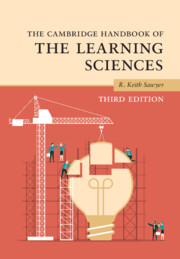Book contents
- The Cambridge Handbook of the Learning Sciences
- The Cambridge Handbook of the Learning Sciences
- Copyright page
- Contents
- Figures
- Tables
- Contributors
- Preface
- 1 An Introduction to the Learning Sciences
- Part I Foundations
- Part II Methodologies
- 9 Design-Based Research
- 10 Analyzing Collaboration
- 11 Microgenetic Methods
- 12 A Learning Sciences Perspective on the Design and Use of Assessment in Education
- 13 Learning Analytics and Educational Data Mining
- Part III Grounding Technology in the Learning Sciences
- Part IV Learning Together
- Part V Learning Disciplinary Knowledge
- Part VI Moving Learning Sciences Research into the Classroom
- Index
- References
12 - A Learning Sciences Perspective on the Design and Use of Assessment in Education
from Part II - Methodologies
Published online by Cambridge University Press: 14 March 2022
- The Cambridge Handbook of the Learning Sciences
- The Cambridge Handbook of the Learning Sciences
- Copyright page
- Contents
- Figures
- Tables
- Contributors
- Preface
- 1 An Introduction to the Learning Sciences
- Part I Foundations
- Part II Methodologies
- 9 Design-Based Research
- 10 Analyzing Collaboration
- 11 Microgenetic Methods
- 12 A Learning Sciences Perspective on the Design and Use of Assessment in Education
- 13 Learning Analytics and Educational Data Mining
- Part III Grounding Technology in the Learning Sciences
- Part IV Learning Together
- Part V Learning Disciplinary Knowledge
- Part VI Moving Learning Sciences Research into the Classroom
- Index
- References
Summary
This chapter reviews assessment research with the goal of helping all readers understand how to design and use effective assessments. The chapter begins by introducing the purposes and contexts of educational assessment. It then presents four related frameworks to guide work on assessment: (1) assessment as a process of reasoning from evidence, (2) assessment driven by models of learning expressed as learning progressions, (3) the use of an evidence-centered design process to develop and interpret assessments, and (4) the centrality of the concept of validity in the design, use, and interpretation of any assessment. The chapter then explores the implications of these frameworks for real-world assessments and for learning sciences research. Most learning sciences research studies deeper learning that goes beyond traditional student assessment, and the field can contribute its insights to help shape the future of educational assessment.
Keywords
- Type
- Chapter
- Information
- The Cambridge Handbook of the Learning Sciences , pp. 238 - 258Publisher: Cambridge University PressPrint publication year: 2022



